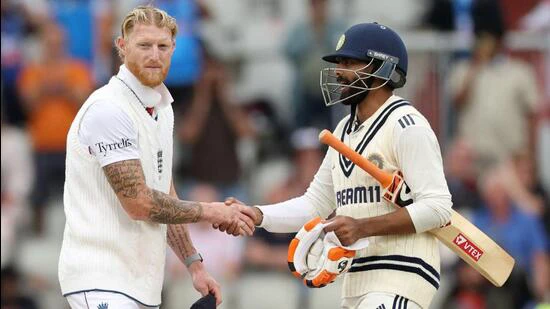For the Indian team, the Oval Test is when they finally came face to face with English cricket conditions they had expected on the tour.
The situation, after almost two months on the road (and four energy sapping games across England during an unusually hot summer) was similar to going to a big party where you meet the host only as you are about to leave.
At Old Trafford, Jadeja famously refused a handshake with Stokes to make a point. At the Oval, India could not turn down the handshake with English cricket.
Cricket, more than other sports, is impacted by conditions – the nature of the pitch and nature itself, heat, breeze, humidity, moisture, cloud cover. Conditions vary from country to country and the challenge of playing in India and overseas is starkly different. For Indian batters used to slow and low pitches, batting in England can be particularly tricky.
The magic mantra is to reboot technique – play late, don’t go hard at the ball. Play with soft hands, close to the body. Abandon all thoughts of hitting through the line. With grey skies, green wickets, swinging/seaming conditions in England, batters with weak techniques get found out. That is why success here brings respect and is a tick on the CV.
This tour, England caught India by surprise. India played four Tests in England in (almost) Indian conditions, in grounds with large number of Indian fans – it was home away from home. But the Oval flicked the switch. The wicket was green, not brown.
The light has been dull for long periods on the first three days. The pitch has been spicy and seaming, not batting friendly. The ball has moved, jumped and come to batters in crooked, wobbly lines instead of staying straight.
Plus the rain and spitting drizzle resulted in a stop-start kind of play, the situation batters dread. When you play, come off and restart, batters are never ‘in’. It’s like being on zero all the time.
But the batters’ nightmare made for riveting, compelling cricket. After the run feast in the previous four Tests this was bat versus ball on more equal terms. The ball repeatedly sailed past the edge, which reminded one of the classic comment about a batsman who kept getting beaten but not edging. Noticing the growing frustration of his bowler the captain comforted him. “Be patient,” he said, “he will nick it soon as he gets his eye in.”
Batters hate interruptions but spectators in England take such pauses in their stride. Soon as the umpires walk off and the ground staff start wheeling in the covers, long queues build around bars and food stalls. They know from experience that rain breaks are part of the game as much as basic uncertainty (it takes one ball to dismiss a player), the law of averages (Bradman made a zero in his last Test innings) and sledging. What would cricket be if there was no on-field needle (Gill versus Crawley, Akash Deep versus Duckett, Prasidh Krishna versus Root) and ‘off-field’ flare ups (Gambhir versus curator).
In a way, it is fitting that India met typical England cricket at the Oval, the scene of their famous first ever series win against England in 1971. Chandrasekhar’s 6/38 is etched in our cricket history as is Gavaskar’s epic 221 during a fourth innings chase.
The Oval, home of Surrey, has a proud history dating back to 1864 when it first won the County championship. At present it is the best performing team, having won the County championship the last three years. Ollie Pope is captain, Sam Curran is a key player and Sai Sudharsan a contracted foreign professional.
Over the years, Surrey has had a long list of greats. Batsmen: Ken Barrington (Test avg 58.67), John Edrich (Test triple hundred) and Peter May (England captain). Bowlers: Alec Bedser (1,500 first class wickets) and Jim Laker (19 wickets in one Test). Surrey’s greatest star is Jack Hobbs, who scored almost 61,000 first-class runs, including a staggering 197 hundreds, half of these after the age of 40.
Interestingly, besides its cricket success, Surrey is one of the few Counties that is commercially profitable. The Oval has successfully monetised its infrastructure and smartly combined cricket and commerce to generate revenue.
In London, The Oval and Lord’s are only a short distance apart but miles away in character and culture. Lord’s is aloof, intimidating, exclusive; Oval functional, friendly, accessible and accepting. It has an India hall, an Australia suite and a West Indies room and hospitality boxes named after Clive Lloyd and Dennis Lillee. The contributions of Intikhab Alam, Kumar Sangakkara and Hashim Amla are recognised and respected.
But Lord’s stands alone in terms of its history and brand value. The Oval team in The Hundred went to MI for around £60 million. Lord’s was bought by a US-based tech group for a whopping £149 million.
